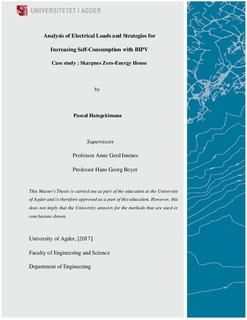| dc.description.abstract | At Skarpnes village (Southern Norway), the houses as zero energy buildings (ZEB) are installed with Building Integrated Photovoltaic (BIPV) systems, and these houses are not containing smart control of equipments. The aim of such buildings is that the amount of electrical energy produced is the same as that consumed in the buildings on an annual basis. In this thesis, the main objective is to analyse the methods for increasing self -consumption in BIPV, by minimizing the cost of purchasing electricity from the grid at time with no PV production, and maximizing the utilization of solar PV generated power, which reduces the power sold back to the grid. To achieve this, two methods for increasing self-consumption, namely demand side management (DSM) and energy storage using domestic hot water (DHW) tank were analyzed. Maximizing self-consumption of residential PV systems is profitable, because the sale cost of exported power to the grid is lower than that of importing power from the grid. To achieve high self- consumption, shiftable loads (e.g. heat pump) are controlled so that solar PV energy utilization especially at time with high solar irradiation can be maximized. The results show that, load shifting play an important role in minimizing the cost of imported energy, for example in May, by storing the excess PV production through DHW tank to be used in the evening or morning the following day. By considrering some selected clear days in six months, this excess PV energy boosted water from 40 0 C to 90 o C, (corresponding to the set limits for minimum and maximum temperature) without assistance from the grid distribution network. Supply and demand cover factors were used to determine when the loads in houses are covered by PV production or not. Based on the available dataset, it has been found that in December 2015 and May 2016, 3.3 % and 56.7 % of demand respectively is covered by solar PV. Loss of load probability (LOLP) is used to analyze the time where load demand is not covered by PV production at desired reliability level. The results of this research are important in implementation of DSM techniques for economic analysis in BIPV systems. Also, the use of excess PV energy storage through DHW tank minimizes the energy exchange between BIPV and the grid. The results of this thesis will contribute further to the investigation of self- consumption analysis in the BIPV systems, by maximizing energy utilization in the BIPV systems.
Keywords: BIPV, PV production, electric loads, self-consumption, cover factors, Load-shifting, heat pump, domestic hot water storage | nb_NO |

